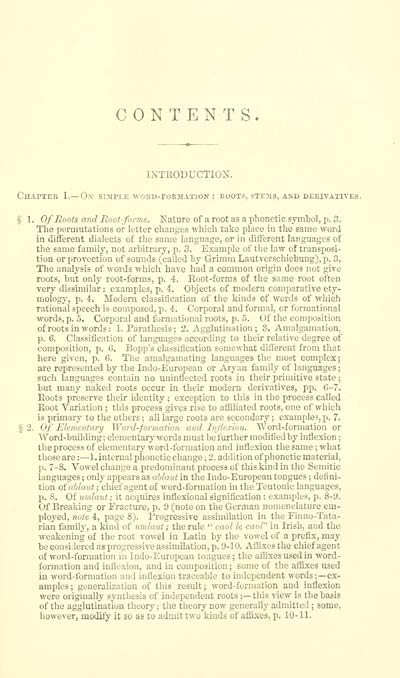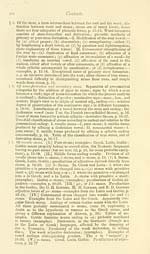Blair Collection > Celtic studies
(23)
Download files
Complete book:
Individual page:
Thumbnail gallery: Grid view | List view

CONTENTS
INTRODUCTION.
Chapter I. — On sijiple word-formation : roots, stems, and derivatives.
§ 1 . Of Roots and Root-forms. Nature of a root as a phonetic symbol, p. 3.
The permutations or letter changes which take place in the same word
in different dialects of the same language, or in different languages of
the same family, not arbitrary, p. 3, Example of the law of transposi-
tion or provection of sounds (called by Grimm Lautverschiebung), p. 3.
The analysis of words which have had a common origin does not give
roots, but only root-forms, p. 4. Root-forms of the same root often
very dissimilar : examples, p. 4. Objects of modern comparative ety-
mology, p. 4. Modern classification of the kinds of words of which
rational speech is composed, p. 4. Corporal and formal, or formational
words, p. 5. Corporal and ibrniational roots, p. 5. Of the composition
of roots in words: 1. Parathesis; 2. Agglutination; 3. Amalgamation,
p. 6. Classification of languages according to their relative degree of
composition, p. G. Bopp's classification somewhat difl'erent from that
here given, p. 6. The amalgamating languages the most complex;
are represented by the Indo-European or Aryan family of languages ;
such languages contain no uninflected roots in their primitive state ;
but many naked roots occur in their modern derivatives, pp. 6-7.
Roots preserve their identity ; exception to this in the process called
Root Variation ; this process gives rise to afiiliated roots, one of which
is primary to the others ; all large roots are secondary ; example?, p. 7.
§ 2. Of Ekmentarij Wordformation and Inflexion. Word-formation or
Word-building ; elementary words must be further modified by inflexion ;
the process of elementary word-formation and inflexion the same ; what
those are : — 1. internal phonetic change ; 2. addition of phonetic material,
p. 7-8. Vowel change a predominant process of this kind in the Semitic
languages ; only appears as ablaut in the Indo-European tongues ; defini-
tion oi ablaut ; chief agent of word- formation in the Teutonic languages,
p. 8. Of umlaut ; it acquires inflexional signification ; examples, p. 8-9.
Of Breaking or Fractm-e, p. 9 (note on the German nomenclature em-
ployed, 7iote 4, page 8). Trogressive assimilation in the Finno-Tata-
rian family, a kind of umlaut; the rule " caol le caoP in Irish, and the
weakening of the root vowel in Latin by the vowel of a prefix, may
be considered as progressive assimilation, p. 9-10. Afiixes the chief agent
of word-formation in Indo-European tongues ; the afiixes used in word-
formation and inflexion, and in composition ; some of the aOLxes used
in word-formation and inflexion traceable to independent words; — ex-
amples; generaUzation of this result; word-formation and inflexion
were originally synthesis of independent roots ;— this view is the basis
of the agglutination theory ; the theory now generaUy admitted ; some,
however, modify it so as to admit two kinds of affixes, p. 10-11.
INTRODUCTION.
Chapter I. — On sijiple word-formation : roots, stems, and derivatives.
§ 1 . Of Roots and Root-forms. Nature of a root as a phonetic symbol, p. 3.
The permutations or letter changes which take place in the same word
in different dialects of the same language, or in different languages of
the same family, not arbitrary, p. 3, Example of the law of transposi-
tion or provection of sounds (called by Grimm Lautverschiebung), p. 3.
The analysis of words which have had a common origin does not give
roots, but only root-forms, p. 4. Root-forms of the same root often
very dissimilar : examples, p. 4. Objects of modern comparative ety-
mology, p. 4. Modern classification of the kinds of words of which
rational speech is composed, p. 4. Corporal and formal, or formational
words, p. 5. Corporal and ibrniational roots, p. 5. Of the composition
of roots in words: 1. Parathesis; 2. Agglutination; 3. Amalgamation,
p. 6. Classification of languages according to their relative degree of
composition, p. G. Bopp's classification somewhat difl'erent from that
here given, p. 6. The amalgamating languages the most complex;
are represented by the Indo-European or Aryan family of languages ;
such languages contain no uninflected roots in their primitive state ;
but many naked roots occur in their modern derivatives, pp. 6-7.
Roots preserve their identity ; exception to this in the process called
Root Variation ; this process gives rise to afiiliated roots, one of which
is primary to the others ; all large roots are secondary ; example?, p. 7.
§ 2. Of Ekmentarij Wordformation and Inflexion. Word-formation or
Word-building ; elementary words must be further modified by inflexion ;
the process of elementary word-formation and inflexion the same ; what
those are : — 1. internal phonetic change ; 2. addition of phonetic material,
p. 7-8. Vowel change a predominant process of this kind in the Semitic
languages ; only appears as ablaut in the Indo-European tongues ; defini-
tion oi ablaut ; chief agent of word- formation in the Teutonic languages,
p. 8. Of umlaut ; it acquires inflexional signification ; examples, p. 8-9.
Of Breaking or Fractm-e, p. 9 (note on the German nomenclature em-
ployed, 7iote 4, page 8). Trogressive assimilation in the Finno-Tata-
rian family, a kind of umlaut; the rule " caol le caoP in Irish, and the
weakening of the root vowel in Latin by the vowel of a prefix, may
be considered as progressive assimilation, p. 9-10. Afiixes the chief agent
of word-formation in Indo-European tongues ; the afiixes used in word-
formation and inflexion, and in composition ; some of the aOLxes used
in word-formation and inflexion traceable to independent words; — ex-
amples; generaUzation of this result; word-formation and inflexion
were originally synthesis of independent roots ;— this view is the basis
of the agglutination theory ; the theory now generaUy admitted ; some,
however, modify it so as to admit two kinds of affixes, p. 10-11.
Set display mode to: Large image | Transcription
Images and transcriptions on this page, including medium image downloads, may be used under the Creative Commons Attribution 4.0 International Licence unless otherwise stated. ![]()
| Early Gaelic Book Collections > Blair Collection > Celtic studies > (23) |
|---|
| Permanent URL | https://digital.nls.uk/75771435 |
|---|
| Description | A selection of books from a collection of more than 500 titles, mostly on religious and literary topics. Also includes some material dealing with other Celtic languages and societies. Collection created towards the end of the 19th century by Lady Evelyn Stewart Murray. |
|---|
| Description | Selected items from five 'Special and Named Printed Collections'. Includes books in Gaelic and other Celtic languages, works about the Gaels, their languages, literature, culture and history. |
|---|

